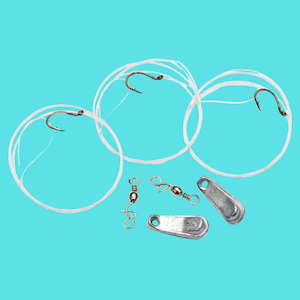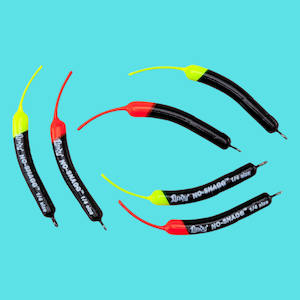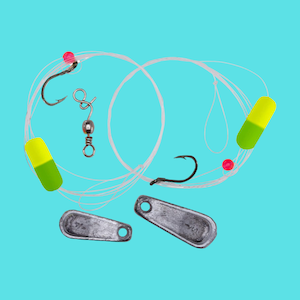A Complete Guide To Lindy Rig Fishing
UPDATED 03 NOVEMBER 2023
by Robert Ceran
It’s impossible to talk about live bait fishing for walleye without including the Lindy rig, which has revolutionized this type of fishing since it was introduced back in the 1960’s.
The Lindy rig is one of the most commonly used fishing rigs for walleye, and is used by millions of anglers every year.
In this article we’ll walk you through the basics of how to tie a Lindy rig, as well as when and how to use it.
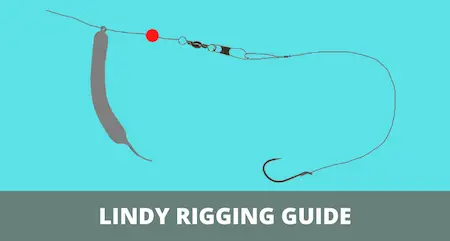
We’ll also show you some of the most effective variations of this rig, which can help you to put a lot more fish in the boat.
What is a Lindy rig?
The Lindy rig is a bottom fishing rig that consists of a sliding sinker, a snap swivel, and a leader with a snelled hook.
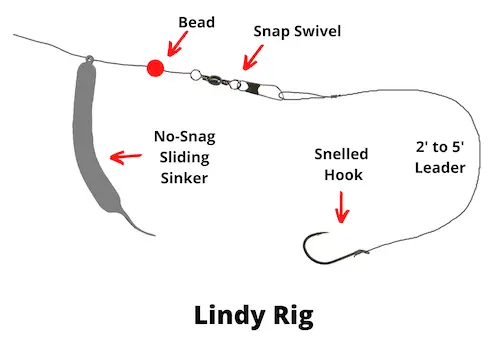
It is predominantly used for walleye fishing, but also works very well for other fish species that like to feed near the bottom, including bass, trout, and catfish.
The original Lindy rig for walleye has been adapted into many different variations, each of which comes with additional features (such as a sliding float to make your bait float above the bottom, to name just one of them).
In fact, many anglers use their own custom version of this classic fishing rig, and we encourage you to do the same after you learn how to tie the basic Lindy rig setup.
Lindy rig setup
Now let’s talk about setting up a Lindy rig. You’ll need the following components for this:
- Main line: 10 to 15 lb test braid or monofilament
- Leader: 4 to 6 lb test fluorocarbon
- Weight: 1/8 to 1 oz sliding sinker
- Swivel: size 4 to 6 snap swivel
- Hook: size 2 to 6 octopus hook
How to set it up: Start by threading your main line through the sliding sinker, and then tie it to the snap swivel. Next, snell a size 4 to 6 hook onto the leader line, measure out 2 to 5 feet of leader length, and then tie a loop at the end of the leader.
Finally, the loop of the leader can be easily clipped onto the snap swivel, and you’re good to go.
It’s generally best to use a Lindy rig for walleye with a 6 to 7 foot long spinning rod with fast action and light to medium light rod weight. The best spinning reel size to use is 2000 to 3000.
Lindy rig weights
Choosing the right weights is essential for getting the best performance out of your Lindy rig set up.
The original version comes with a Lindy walking sinker, which is a flat, elongated and curved piece of lead with a large eye at the top that allows line to pass through it easily.
However, a more advanced version of the sinker is the Lindy no-snagg sinker, which is a banana shaped sliding sinker that has a wire extension at its bottom, which makes it much less likely to get snagged on bottom structure (see image below).
We highly recommend using no snag sinkers, as that will enable you to avoid constantly getting your weight snagged.
With that being said, you can definitely also use any other kind of sliding weight, including bullet, egg or bank sinkers.
Lindy rig variants
There are countless variations of the Lindy rig for walleye, and we can’t possibly cover all of them here.
But we do want to cover 3 of the most important ones that have significantly improved the performance of the rig, and made it more effective for catching fish in specific situations.
Floating Lindy rig
One issue with the original Lindy fishing rig is that it tends to present your hook right on the bottom, which isn’t always ideal, as many fish (including walleye and trout) are more likely to eat bait that is suspended slightly above the bottom, compared to bait that’s lying directly on the bottom.
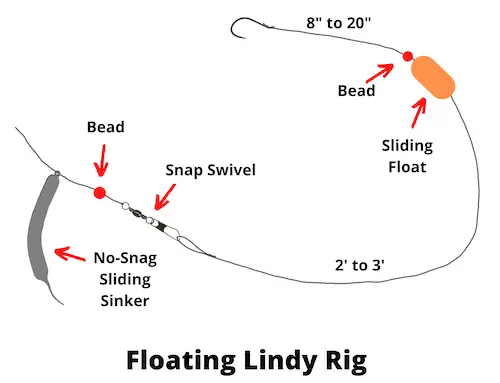
The floating Lindy rig solves this problem ingeniously. It includes a sliding float threaded onto the leader line, which lifts your baited hook up above the bottom.
This is especially useful when there are weeds growing on the bottom, and you want your hook to float up above them.
By setting the total length of your leader, as well as the length of the line between the float and the hook, you can get your bait to float just above the weeds, where it can be found by any fish cruising past.
A plastic or glass bead is used to stop the float from sliding all the way onto the hook.
You can fix the bead to the leader by looping the line through it several times, or you can use a bead peg to stop it from sliding.
Lindy rig with floating jig head
Using a floating jig head is another way to make your bait float up off the bottom.
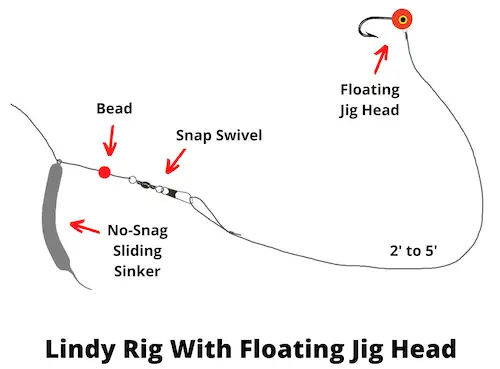
This is especially popular for fishing a floating minnow rig for walleye, where the floating jig head is baited with a live minnow.
Tie this rig just as you would the original version, but instead of snelling a hook onto the leader, tie on a size 2 to 4 floating jig head.
Another great thing about this is that you can experiment with different jig head colors to make your presentation more attractive.
Lindy rig with crawler harness
The Lindy fishing rig is a great option for trolling walleye, as it allows you to present your bait close to the bottom, which is where walleye are most often to be found.
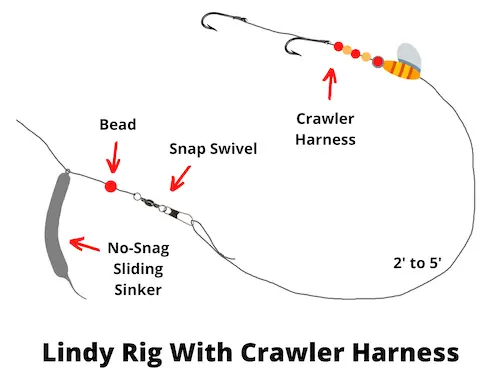
And one of the best bait presentations you can use with the Lindy rig for trolling walleye is the crawler harness, since nightcrawlers are one of the best baits for walleye during the summer months.
You can either tie your own worm harness, or buy it ready made from the tackle store. Once you have your crawler rig ready, you can just clip the loop at the end of the leader to the snap swivel, and your Lindy crawler rig is ready to go.
When using a Lindy rig worm harness, you may want to thread a float onto the leader, as that helps to make the crawler float off the bottom.
Brief Lindy rig history
The Lindy rig was invented in 1968 by the late Ron Lindner, and rapidly rose to legendary status among anglers as one of the best bottom fishing rigs on the market, especially when it comes to targeting walleye.
According to Ron, more than 70 million pre-tied Lindy rigs have been sold, and if you add this to the number of anglers who tie their own Lindy rigs, it’s safe to say that millions of anglers use this rig every season.
In addition to the original Lindy rig for walleye, countless variations of it have been created since 1968, and we’ve covered some of the most important ones above.
How to fish a lindy rig
Lindy fishing is extremely versatile, and can be done in many different ways. You can cast it out with a baited hook and wait for a fish to pass by, you can cast and retrieve it, drift it, or troll it.
Lindy rig trolling
When trolling with a Lindy rig, it’s important to maintain contact with the bottom all the time, which requires using the right size weight combined with the right trolling speed.
As a rule of thumb, it’s best to keep your line at a 45 degree angle, and feel for regular bottom contact with your sliding sinker.
The best Lindy rig trolling speed is about 1 to 1.5 mph, and you’ll probably want to upsize your sinker to 1 or 1 1/2 oz in order to get it down to the bottom effectively.
Especially if you’re trolling a nightcrawler Lindy rig, you don’t want to troll too fast, so you don’t rip the worm off the harness. For trolling, you can also use it with a slow death setup, which works great with nightcrawlers.
Lindy rig drift fishing
Lindy rig fishing is ideal for walleye drift fishing, as it allows you to drag your sinker slowly across the bottom, while keeping your bait in the strike zone at all times.
This is an excellent method for fishing live bait for walleye on top of prominent underwater structures in lakes, such as underwater hills, reefs, or saddles.
Similar to trolling, you should try to maintain regular bottom contact with your sinker, while using a floating jig head to keep your live bait floating above the bottom.
Fishing a Lindy rig from shore
When fishing from shore with a Lindy rig, it’s usually best to use a stationary fishing tactic, where you cast out your bait and wait for a fish to cruise by and grab the bait.
Especially when using live bait, it’s better to avoid repeatedly casting and retrieving your rig, as that will cause the bait to be torn off the hook in most cases.

